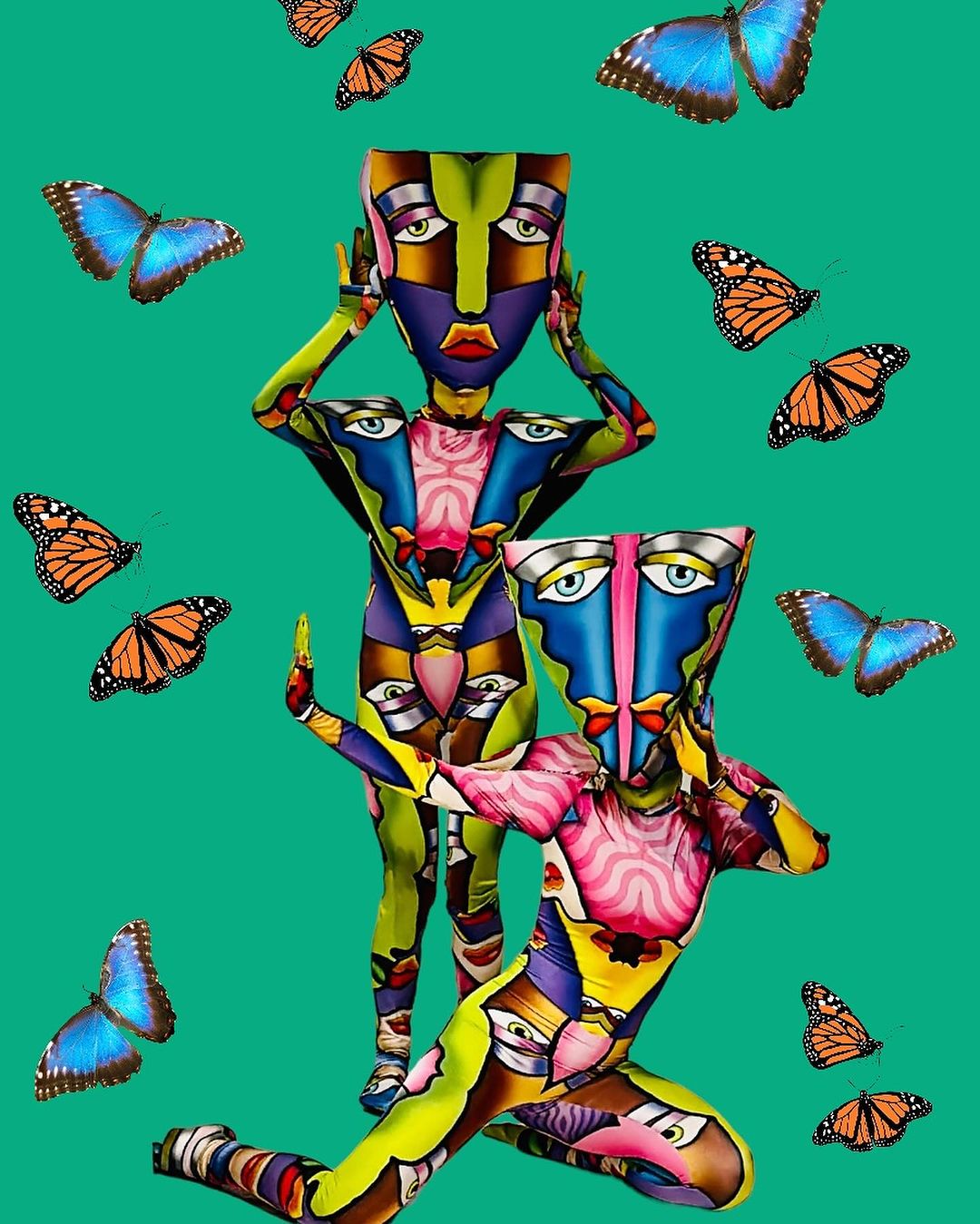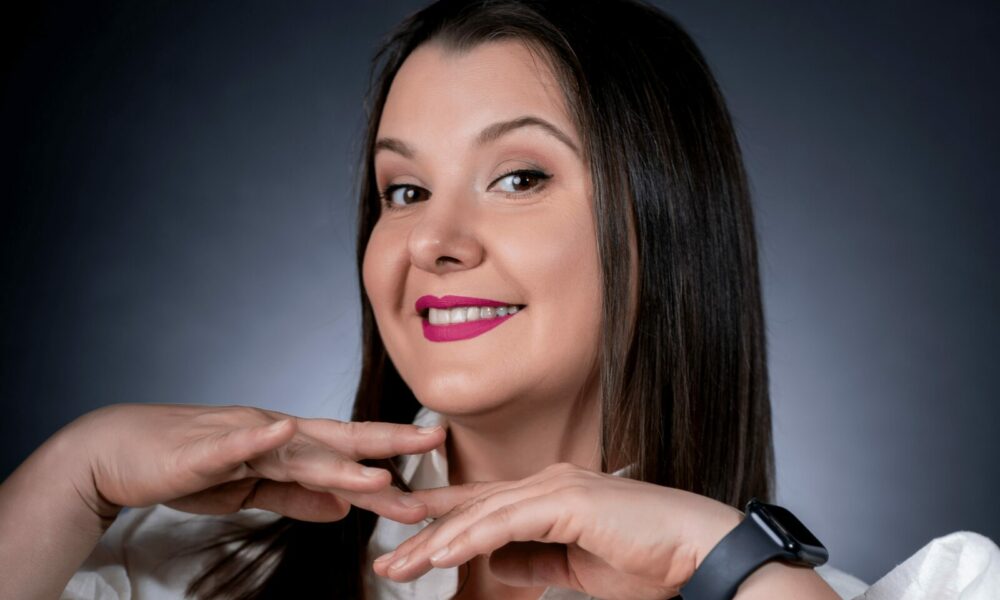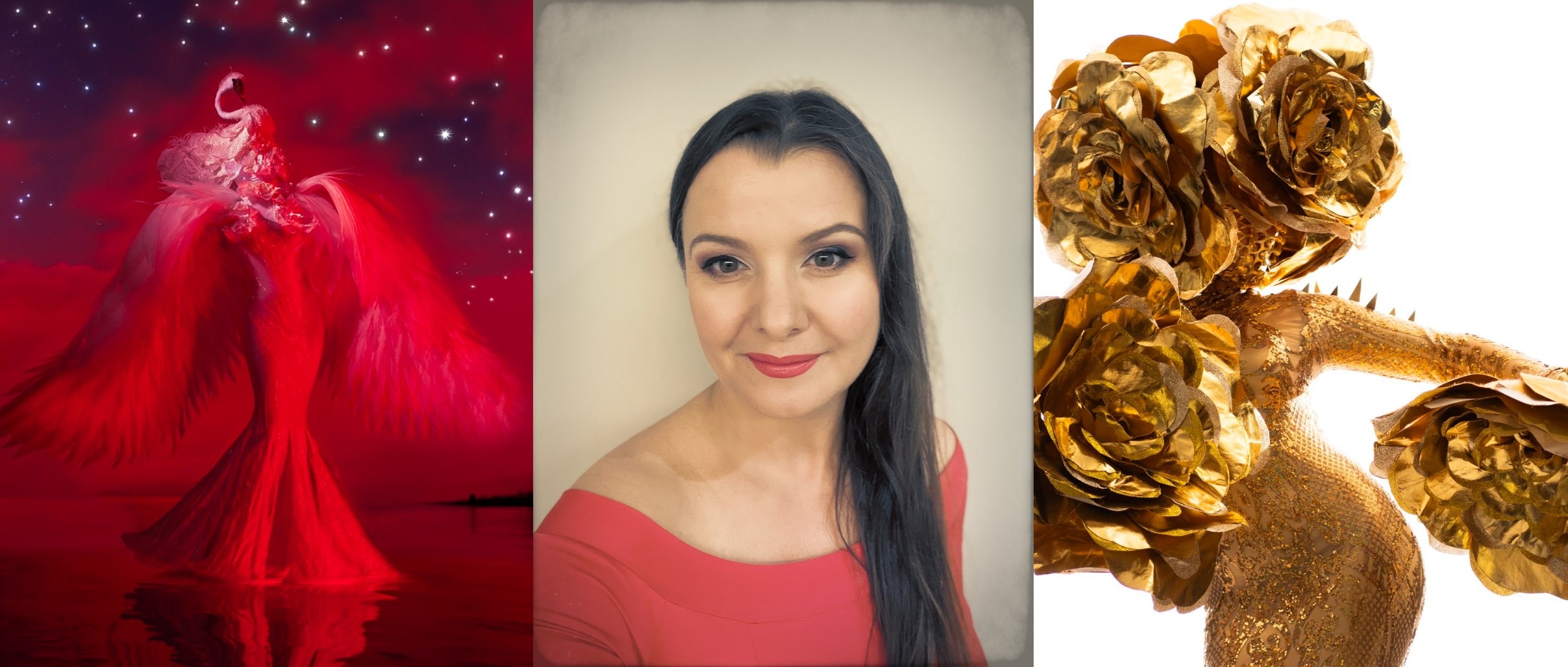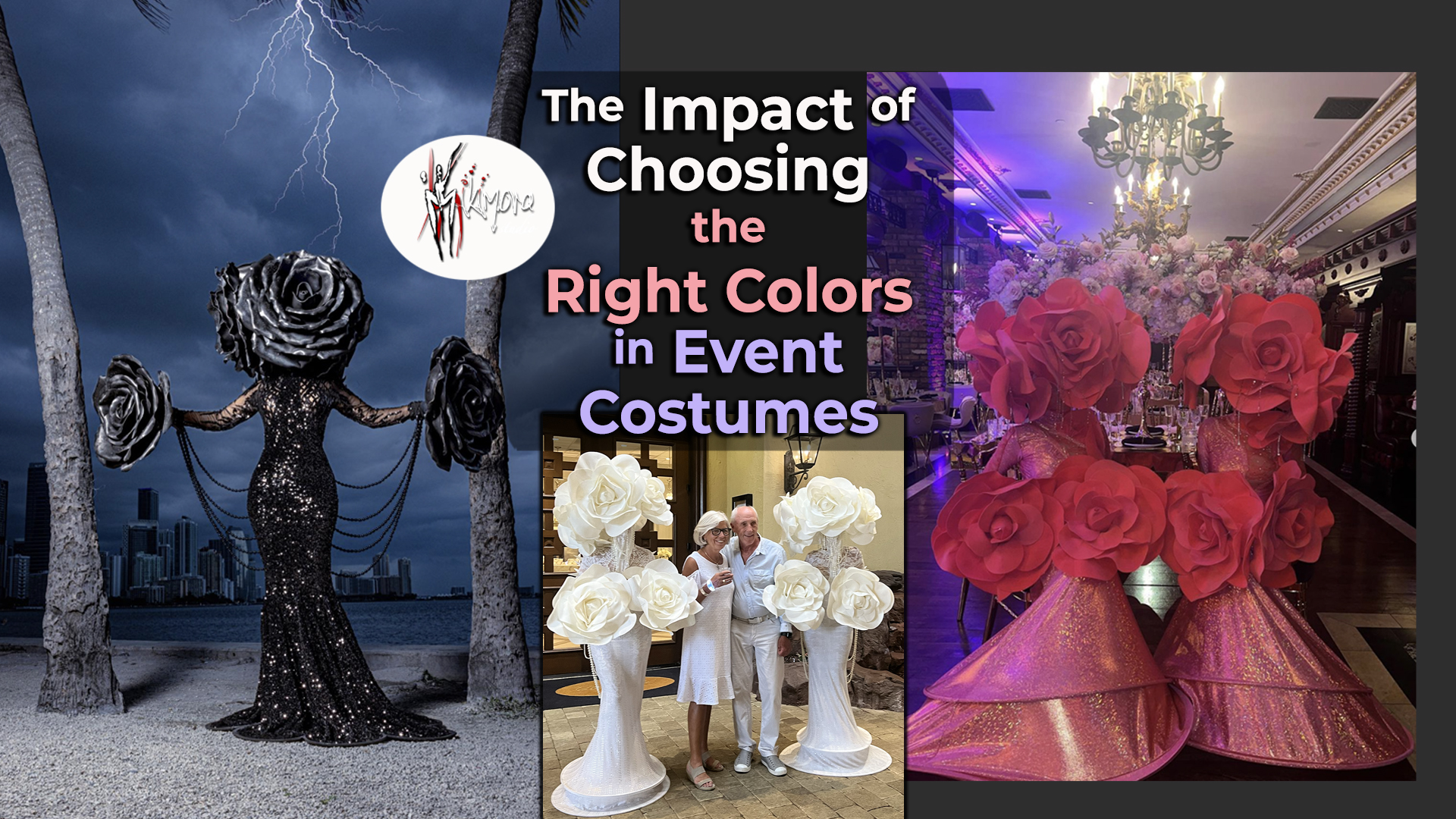
Olga Saretsky is Bridging the Gap Between Performance Art and the Functionality of Wearable Art
Olga Saretsky, born in 1977 to her Russian parents, is the multi-talented founder of Kikimora Inc., renowned for its distinctive Kikimora Studio Art and Kikimora Fashion Clothing Brand. Right from childhood, Olga showed a knack for performance arts, putting on spontaneous dances and interpretive shows for her family. Eventually, with her mother’s support, she took up dance and music classes, never imagining that she would grow to become a well-known performance artist.
At just 15, Olga’s talent earned her a spot at a local radio station as a dancer and choreographer. Over the years, her journey has taken her across various countries in the world—including residing in the US. However, in 2011, after a transformative six years in the US, Olga started her entrepreneurial adventure. She envisioned creating unique Art Characters—innovative living statues for art galleries, events, and gatherings.

Teaching herself to work with wire, foam, fabric, and glue, she brought her imaginative designs to life, each new project a thrilling exploration.
Hi, Olga. Please introduce yourself and state where you are from.
Hello. My name is Olga Saretsky and I am of Russian nationality—born and raised in Kazakhstan. For the past 20 years, I have been residing in Miami, Florida.
Please give us a brief background of what your early childhood was like and how it influenced your style of art.

I was born into an artistic family, with my father working as an Art Director for city events in Kazakhstan. Despite his career, I never had the opportunity to attend art school although I passionately wanted to. My love for drawing and dancing was evident from an early age. The collapse of the Soviet Union and the resulting hardships deeply influenced my artistic path as these struggles revealed many aspects of human behavior, which I used as fuel in my pursuit of beauty. My love for performance grew from experiencing a wide range of emotions.
You mentioned that you attended music and dance classes when you were younger. Was that where you had an eureka moment and realized your love for wearable art?
During my early school years, I attended dance classes and music school, where I practised guitar and piano. Dance was my true passion, and I found it easy to learn various styles. From a very young age, I dreamed of becoming a dancer, circus performer, and fashion designer. I had two distinct sides: a girly side that loved dressing dolls in my old clothes, and a masculine side where I enjoyed playing sports and exploring nature with my younger brothers. Up until around age 14, I often wished I were a boy.

Which unique experiences or notable events have had a big impact on your work in creating wearable art?
I consider three notable events that significantly influenced my performance art career. First, at age 21, I travelled to Thailand for a dance contract in a prestigious European variety show. There, I experienced rich Thai culture, innovative costumes, and grand theatrical presentations. Second, at age 27, I travelled to the United States, where I expanded my dance and movement repertoire. In the US, I applied my talents in dance theatre and burlesque and developed a deep passion for oriental belly dance.
Third, my consistent work in Miami’s local nightclubs required me to create my costumes, which led to experimenting with new costume-making techniques and performing in them the same night. The audience’s reactions to my shows gradually steered me toward avant-garde and surrealism. Creating bizarre-looking costumes brought me immense pleasure, and I was delighted to find strong support from the audience.
https://www.instagram.com/reel/C20BRfsMu6e/embed/?cr=1&v=14&wp=759&rd=https%3A%2F%2Fwww.prazzleinc.com&rp=%2Fblog%2Folga-saretsky-is-bridging-the-gap-between-performance-art-and-the-functionality-of-wearable-art#%7B%22ci%22%3A0%2C%22os%22%3A5135.0999999996275%2C%22ls%22%3A4872.699999999255%2C%22le%22%3A5130.699999999255%7D
How do you create wearable art that strikes a balance between aesthetics and functionality? And, what kind of message or emotion do you intend to pass across with your pieces?
Being an active dancer with experience in various performance art disciplines such as hip-hop, ballet, belly dance, and mime has given me a rich understanding of the power of simple movements. I’ve learned that to express strong feelings, I don’t need fast or acrobatic moves. Hip-hop taught me a sense of rebellion, ballet instilled a sense of lines and grace, belly dance provided a sense of isolation movements, and mime gave me a profound connection to the moment and the audience.
By combining these disciplines, I can mix them uniquely to create wearable art that balances aesthetics and functionality. Each character I create embodies specific feelings and movements. Often, I don’t know how a new creation will look until it’s finished, and only then do I understand how it will move. So each piece I create carries specific emotions and feelings, though sometimes these emotions are mixed. The expression of these feelings can vary depending on the performance’s time, location, and lighting, which I love because it creates an illusion of appearances.

To be honest, I enjoy it when the audience is slightly confused by what they see, trying to grasp a name for the character or understand the feelings they encounter. I believe that a confused audience is more present in the moment, connecting more deeply with the performance and assigning their meanings. Even well-known pieces like Living Roses™, which represent the opulence and beauty of a blooming garden, sometimes evoke deep fears of the unknown in the audience, and I love that dynamic.
Which of the pieces you made was the most difficult, and how did you overcome the difficulties?
Two pieces stand out in my memory as the most challenging: the creation of the Red Siamese Twins and the Flower Spirit characters. The Red Siamese Twins was a complex project where I had to design a seamless costume for imaginable conjoined alien twins, with arms appearing as tentacles and faces on the hand area. I remember nearly giving up on this piece for my first wearable art fashion show in 2011. However, I persisted and completed this iconic piece, which I later remade in an alternative silver colour.

The second challenging piece was the Flower Spirit characters. Surprisingly, the intricate multicolour arrangements on the headpieces and dress were very difficult and time-consuming. I struggled to decide where to place each small flower, which led to mental exhaustion. This project gave me a newfound respect for professional flower arrangers. It was not as easy as I had imagined, but it turned out to be one of the most spiritual and profound processes I ever experienced in 2014.
To overcome difficulties, I often take a break from my current project and switch to a different art discipline, read a book, or take a walk in nature. It’s not easy for me to step away, as I’m naturally very focused and love to complete my pieces quickly. However, I’ve learned that being focused doesn’t mean clinging to the task. Taking breaks has been a valuable lesson in maintaining creativity and clarity.
Have you ever used interactive elements or technology in your wearable art pieces? If so, how?
Yes, I strive to create interactive elements for the audience because our shows take place on the same floor as the audience, allowing for close interaction and photo opportunities. I love to use props and often choreograph specific movements for each character to spark engagement and interaction. For example, our white sculpture piece named “Connected” is not only mesmerizing to watch but also encourages guests to participate by getting tangled in the stretch fabric we pull between each other. We prioritize creating shows with audience interactions to enhance the experience.
What was the inspiration behind your wearable art, Living Roses™ (2024)? Walk us through the process from initial idea conception to finishing touches.
The inspiration for Living Roses™ came to me very naturally and spontaneously. While shopping for materials, I was instantly captivated by artificial foam flowers, and in a split second, I envisioned the full costume and its movements. The creation process was swift; I crafted the White Living Roses™ within two days and performed in it the same week in November 2016. Since 2016, I have created an extensive Living Roses™ collection, each representing different colour vibrations, with many more to come.
https://www.instagram.com/reel/C4G-HrCLPEZ/embed/?cr=1&v=14&wp=759&rd=https%3A%2F%2Fwww.prazzleinc.com&rp=%2Fblog%2Folga-saretsky-is-bridging-the-gap-between-performance-art-and-the-functionality-of-wearable-art#%7B%22ci%22%3A1%2C%22os%22%3A5139.299999999814%2C%22ls%22%3A4872.699999999255%2C%22le%22%3A5130.699999999255%7D
I have always been fascinated by mermaid-shaped dresses, which led me to design the body of the costume to resemble a vase. The headpiece features a large rose bloom, with lace and pearls gently covering the face to evoke a sense of mystery and enchantment. My goal was to create the feeling of a white marble statue coming to life with slow and elegant movements, drawing from my ballet and belly dance training to achieve the effect of a flower flowing in the wind. The costume’s two large flowers extend and close as if they are breathing with the wind.
My connection to roses, my favourite flower, began in childhood, watching my grandmother cultivate beautiful roses in our backyard. I had never seen anyone create a rose costume like mine, which is entirely monochromatic. This unique twist in colour set my design apart from others. To me, Living Roses™ represents feminine beauty, mystery, and vulnerable opulence.
Did you attend a fashion school after you discovered you would like to spend the rest of your life making wearable art?

Yes, I attended a three-year fashion design college in Kazakhstan during my late teenage years, where I learned the basics of clothing design and construction. Despite finishing school, I initially hated sewing and only wanted to dance and design dance costumes. After school, I didn’t sew anything myself. Instead, I would draw concepts, choose fabrics, and hand everything off to a seamstress to handle the construction.
When I arrived in the US at age 27 and began performing solo, I realized I couldn’t afford a seamstress. This led me to purchase my first sewing machine and experiment on my own. After a decade of not sewing, I had to teach myself how to operate the machine and create patterns through trial and error. I’m very grateful for this challenge because it brought out the designer in me. I learned to flow freely with my ideas and embrace the most outrageous designs my mind could produce.

Interestingly, many of my unique early designs resulted from mistakes that I fell in love with. Since 2011, I have been self-taught, and my art evolved significantly once I began incorporating wire, foam, and glue into my process. These materials allowed me to develop unique techniques and shapes. I continue to learn as I go, always finding a way to bring my specific visions to life. This journey is very personal and spiritual for me.
As a female-presenting heterosexual woman, how has your gender influenced your expression and your audience’s perception of your art over the years?
I’m bisexual and love all genders—love is love for me. I’ve been attracted to both men and women at different times, depending on the connection I feel with a person. It’s hard to pinpoint exactly how my bisexuality has influenced my art, but it’s evident that I predominantly design for females, which speaks for itself. Let me try to explain: I love to showcase female energy in many ways. Growing up wishing to be a boy, I developed many traits not typically associated with females.
https://www.instagram.com/reel/C6JcufCrEVQ/embed/?cr=1&v=14&wp=759&rd=https%3A%2F%2Fwww.prazzleinc.com&rp=%2Fblog%2Folga-saretsky-is-bridging-the-gap-between-performance-art-and-the-functionality-of-wearable-art#%7B%22ci%22%3A2%2C%22os%22%3A5143.299999999814%2C%22ls%22%3A4872.699999999255%2C%22le%22%3A5130.699999999255%7D
This may be why I often create costumes with covered faces—to show that, regardless of gender, a performer can embody whoever they want to be or whatever the character represents. After spending half of my career as a showgirl, I found escape and freedom in my costumes, allowing me to become anyone I wanted for that day or performance. Freedom is the ultimate drive and purpose behind all of my creations.
How has your art evolved over the years based on your personal growth? And, highlighting wins and challenges, how have these growths influenced your art?
The turning point in my artistic expression came when I began sewing myself. I realized that the creation process is essential for connecting with myself. Many designs didn’t take shape in my mind until I started working on them, and this realization was eye-opening, profoundly affecting my entire art career and life. I’ve learned that you can’t fully envision the path ahead until you take the first step, and as I move forward step by step, the road unfolds in the most surprising and marvellous ways.

This understanding has become a guiding principle, inspiring me to pursue ideas that are five to ten years ahead of my time. Embracing this process has allowed me to grow continuously, and knowing this secret process will always be with me fuels my creativity and passion.
Looking back to when you began as an artist, what was one thing you wished someone had told you? Like advice to your younger artist self that would have made your artist journey easier.
To my younger self, I would say this: “Don’t stress and trust the process.” I wish someone had told me, “You are enough. All the secrets and answers you seek are already within you and will reveal themselves in perfect timing.”

What is one quote that you live by and what is the story behind it?
My longtime favourite quote, which also serves as my email signature, is by Jalal ad-Din Rumi: “Let the beauty of what you love be what you do.” This quote resonates deeply with me, reminding me to align my passions with my work and to infuse beauty into everything I create.
If you were given a chance to become a dancer or musician and not a wearable art artist, would you take it? And why?
I would embrace being a dancer, musician, or painter if wearable art were not an option. For me, art is art, just as love is love. The ability to express feelings through art is a sacred experience, regardless of the discipline I choose. I believe that business is also a form of art that I enjoy practicing and continually learning about.


